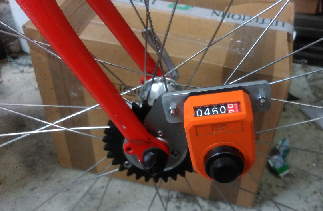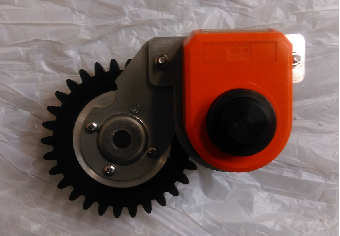The History of Course Measurement and the Jones Counter
Below is an extract from “26.2 Marathon Stories” by Kathrine Switzer and Roger Robinson.
“ The one thing that can be confidently legislated is the distance. Dedicated work in the last half of the 20th century by skilled enthusiasts such as Alan Jones and John Jewell in the UK, Ted Corbitt in the US, and Norm Patenaude in Canada led to techniques and technology that at last ensured accurate measurement. Jones replaced time-consuming surveyors’ methods with a simple device that counts the revolutions of a calibrated bicycle wheel. It is now known as the Clain Jones counter, after Alan’s son who took over the assembly process. The Association of International Marathons and Road Races (AIMS) has a team of expert measurement administrators who maintain standards around the world. The rare cases of inaccurate measurement enrich marathon folklore and blog sites. But almost always, whatever the effects of hills, crowds, footings, or weather, you can be sure you have run the right distance: 26.2 miles/ 42.2 km. The distance is forever. ”
The method of measurement as we know it today was developed in 1961 by John Jewell [1], he took the calibrated bicycle method used by the Road Time Trial Council of British cyclists and refined it. This used a revolution counter to record the number of complete revolutions of the front wheel and then he counted the number of spokes to record the fraction of the revolution.
Jewell’s method not only influenced the development in the UK, but went on to be adopted internationally. A major aspect that led to this adoption was Jewell’s friendship with American ultra distance runner, Ted Corbitt. Corbitt led the introduction of Jewell’s methods in the USA, and in 1964 under the auspices of the Road Runners Club, USA published a paper entitled “Measuring Road Running Courses”.
Corbitt’s work helped
inspire Alan Jones [2] develop and produce “Jones Counter” in 1970, Jones’ new
counter removed the need to count spokes as in Jewell’s method of measuring.
Jones reported “I really didn’t want to get involved with this so I asked my
son, Clain, who was nine years old if he wanted to help. Since Clain was good
with his hands and loved money he agreed. The assembly was really too much for
him but he was able to do a bit of the work and I paid him $1.00 for each one.
This made the manufacture a break-even proposition for me.” The counters became
known as the Clain Jones Counter and were produced between 1973 and 1982.
As Clain looked to go to college there was a need to find someone else to take over the business. Corbitt managed to get Allan Steinfeld, President of the New York Road Runners Club, interested. The NYRRC bought the business in 1983 and Bill Noel took on the role of running it, the NYRRC Jones Counter [3], this continued until around 1990.
Around
1990, Paul Oerth [3] took up production of the counter and
removed the need for the two parts to be held together by wire, they were now
bonded together [2]. In 2006, the production of the gears used
in the counter ceased, an alternative was introduced but this was short-lived
and the Jones-Oerth Counter went out
of production.
.png?timestamp=1446432048454) In 2008 Tom and Pete Riegel [4]
started
looking at the design and fabrication of a new gear drive. The new Jones Counter, Model JR became
available in April 2008, this version of the counter was different to previous
models as the counter is read from left to right rather than from the side.
In 2008 Tom and Pete Riegel [4]
started
looking at the design and fabrication of a new gear drive. The new Jones Counter, Model JR became
available in April 2008, this version of the counter was different to previous
models as the counter is read from left to right rather than from the side.
.png?timestamp=1446433046262) In
late 2014 an improvement to the JR model was made, this saw a thicker and
stronger drive gear and tang.
In
late 2014 an improvement to the JR model was made, this saw a thicker and
stronger drive gear and tang.
2008 model
2014 model
In 2015 the Cook-Jones
Counter went into production, whereas previous counters had been produced
in the USA, this new model was designed and made in the UK. The process of
getting to the final version started back in 2011. Having qualified as a UK
Course Measurer in 2010 Phil Cook had had some problems fitting the Model JR to
his bike, so asked his father, Tony Cook, to modify the drive gear by extending
the tang in order to engage with the spokes. After a while the original tang
bent so a further adjustment was needed, this seemed to work until it was
noticed that the drive gear had bent and was barely meshing with the counter
gear. Once again Phil approached his dad for help, asking if he could
straighten the drive gear, to his surprise when he received his bike back all
that remained of the original set up was the counter, counter gear and holding
bracket, the drive gear had been removed and a new drive gear had been machined
and attached directly to the spokes of the wheel, and this set up still remains
on Phil’s bike. One advantage of this new set up is that there is no lag before
a reading starts, whether moving the wheel forward or backwards due to the
direct drive between the two gears. The original thought was to offer this modification
to any measurers in the UK that were interested, then we decided to explore the
possibilities of manufacturing the whole unit. The biggest difficulty was sourcing
a supplier of a counter that we were happy with as the Veeder-Root counter was
excessively expensive. A model exactly the same as our modification was
produced, but Tony wasn’t happy with the quality of the counter. .png?timestamp=1446433300663)
After weeks of
searching the internet and catalogues a possible counter was found, so one unit
was ordered, the next stage was to find a suitable counter gear – as we already
had access to a drive gear through the modification, it was decided that due to
the design required to achieve the set up needed it was easier to machine the
gears from scratch. .png?timestamp=1446433370879) The next thing was to work out how to fit the counter to
the bike, the new counter was larger and more robust than the Model JR counter,
so it was decided to come up with a design which allowed the counter to be
easily removed from the bike when not measuring. With a design decided on and a
sample produced, this was sent to other measurers who were interested in trying
it out – the feedback was very positive. From the feedback received a final
modification was made. The drive gear was resized and the ratio adjusted, the
Model JR has a ratio of 2.36:1 (26T:11T), the prototype had a ration of 2:1
(26T:13T), the new finalised Jones-Cook Counter has a ratio of 2.5:1 (30T:12T).
The next thing was to work out how to fit the counter to
the bike, the new counter was larger and more robust than the Model JR counter,
so it was decided to come up with a design which allowed the counter to be
easily removed from the bike when not measuring. With a design decided on and a
sample produced, this was sent to other measurers who were interested in trying
it out – the feedback was very positive. From the feedback received a final
modification was made. The drive gear was resized and the ratio adjusted, the
Model JR has a ratio of 2.36:1 (26T:11T), the prototype had a ration of 2:1
(26T:13T), the new finalised Jones-Cook Counter has a ratio of 2.5:1 (30T:12T).
Following some further testing the design was further upgraded, the method of holding the counter was improved and a smoother running was achieved. During these further improvements a second model was developed which now allowed 2 options to be offered: a 1 piece model and a 2 piece model, both upgraded models went on sale in 2016.


Some further refining of the designs has taken place to take into account the slight changes in fork design.
References
[1] http://www.coursemeasurement.org.uk/history--/index.htm
[3] https://en.wikipedia.org/wiki/Jones_Counter
[4] http://www.jonescounter.com/2.html
Images found via Google Images.